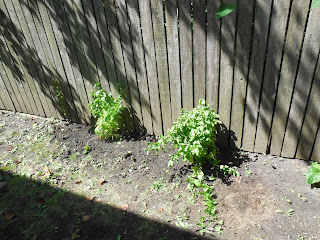We have several high end and ethnic grocery stores in our
area. One of them sells olives in an
olive bar. I got a container with a
mixture of all the olives available in the bar that were already pitted to use
in the recipe. If this is not possible
where you live, get a can of black ripe olives and a jar of pitted large green
olives or Kalamata olives. The recipe will still be quite tasty.
We made this several times in July, serving it to party guests and at the Garden
Club meeting. In the process I found my
favorite version was when we grilled the peppers and mushrooms before chopping
them into the blend. The sweetness of
the grilled peppers and the smokiness of the mushrooms really added great
flavor components to the dish.
One batch was made with sautéed peppers, mushrooms and
olives that hubby had left over from making breakfast omelets. This was sweet
and savory at the same time.
The best part about the recipe was that no version was
bad. They were all tasty, all popular
with others, and all disappeared in a day.
Mushroom Muffalatta Dip / Salsa
¾ to 1 cup Olives, pitted (can be brined or olive oil cured),
chopped fine
1 red sweet pepper, chopped fine
3 to 4 button or bebe mushrooms, chopped fine
1 Shallot, chopped fine
1 clove garlic, minced
1 to 2 Tbls. fresh flat parsley, minced
2 teaspoons oregano, minced (or 1 tsp dry)
¼ cup olive oil
2 Tbls. Wine or herbal vinegar
Directions:
You can hand chop the vegetables or use a food processor. You do not want to make this into a paste,
you want to see the chunks. I hand
chopped the olives, peppers and mushrooms and herbs.
Place chopped olives, peppers, and mushrooms in a bowl. In a smaller bowl combine minced herbs, olive
oil and vinegar. Whisk together. Pour over other ingredients and combine
well. Allow to meld in refrigerator for
an hour or more before serving.
Serve with sliced bread or crackers like a crostini.
Optional preparation method: to make this into a sandwich spread,
run the olives, vegetables and mushrooms in a food processor, then add herbs,
oil and vinegar and blend until you create a paste. Spread on sandwiches. Will keep up to a month in the refrigerator.

 The beans are in bloom now at the end of August and I expect to get a bumper crop of beans to plant next year and share with others. I think next year I will find a way for them to grow sideways along the white fence, because the flowers are striking pinkish purple and stand out on the white extremely well.
The beans are in bloom now at the end of August and I expect to get a bumper crop of beans to plant next year and share with others. I think next year I will find a way for them to grow sideways along the white fence, because the flowers are striking pinkish purple and stand out on the white extremely well.








 The beans are in bloom now at the end of August and I expect to get a bumper crop of beans to plant next year and share with others. I think next year I will find a way for them to grow sideways along the white fence, because the flowers are striking pinkish purple and stand out on the white extremely well.
The beans are in bloom now at the end of August and I expect to get a bumper crop of beans to plant next year and share with others. I think next year I will find a way for them to grow sideways along the white fence, because the flowers are striking pinkish purple and stand out on the white extremely well.

































